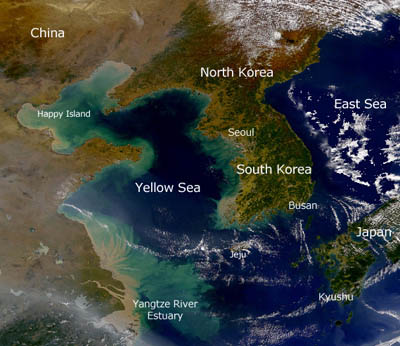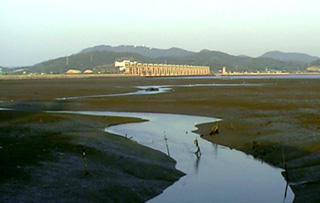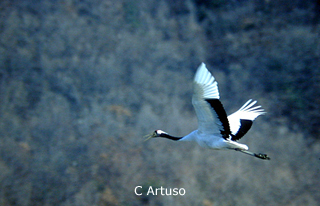
South Korea lacks endemic bird species, and is rather poor in terms of avian "dry land" diversity compared with other East Asian countries, but its wetlands and waterways are extremely important for the future conservation of migratory waterbird species, around 13 of which are globally threatened, and for the future well-being of the human population. Its extensive tidal-flats support three charismatic and threatened near-endemic breeding species (Saunders's Gull Larus saundersi, Chinese Egret Egretta eulophotes, and Black-faced Spoonbill Platelea minor) and a very significant percentage of the East Asian Australasian Flyway's shorebirds. Rivers, reclamation lakes and rice-fields support more than 1 million migrant and overwintering waterbirds, including most of the world's Baikal Teal Anas formosa, White-naped Grus vipio and Hooded Cranes Grus monacha. Amongst East Asian countries it has one of the richest economies and one of the strongest environmental movements too, boding well for long-term conservation. Yet, presumably as it lacks an international NGO and has not yet received much interest from foreign birders, South Korea still remains something of a relative unknown to the world's conservation and birding communities. This section of the site therefore aims to highlight the importance of its wetlands for migratory bird populations, with additional information given on threats and conservation initiatives.
Geography and Climate

South Korea forms the southern part of the north-south oriented Korean peninsula, lying broadly between 34 and 38 degrees North, and between 126 and 130 degrees East.
It is surrounded by sea on three sides, with the Yellow Sea to the west (bordered by China, North Korea and South Korea this semi-enclosed shallow sea has an average depth across the whole of only 44 m), the South Sea or "Tsushima Strait" to the south, and the deep East Sea (or Sea of Japan) to the east. Due to these seas' ameliorating effects, South Korea has elements of both continental and maritime-temperate climates.
Winters are generally dry and cold with periods of prolonged subzero temperatures in the north, especially away from the coast, but often milder, wetter conditions in the south, leading to inland rivers freezing in the north but largely unfrozen tidal-flats and coastal reclamation lakes in the southwest and southeast (determining the mid-winter distribution of species such as Saunders's Gull and Baikal Teal). Summers are generally hot and humid (with daily maxima typically above 30C in the warmest areas), and the heaviest rains usually fall between June and September, either as part of summer monsoons or carried by typhoons. Drought conditions are reasonably frequent, further stretching very limited water resources.
Wetlands
There are two broad categories of wetland supporting significant concentrations of waterbird in South Korea and the food needs of much of the human population: intertidal/tidal and freshwater. Both should be considered global conservation priorities. As of 1998, tidal-flats covered approximately 280 000 ha (with most unvegetated, and only small areas supporting Suaeda saltmarsh), while the 6 major flood-plain/coastal plain areas nationwide (5 in the west, one in the southeast) now contain most of the freshwater waterbird habitat.
Intertidal Wetlands

Due to differences in coastal slope and tidal-ranges, intertidal wetlands are not distributed evenly around the coast, and approximately 83% of tidal-flats are found along the west coast, with 17% along the south coast.
Most major rivers (including the Geum in the west, the Yeongsan in the southwest and the Nakdong in the southeast) have been barraged at their estuaries since the late 1980s, effectively removing the brackish estuarine zone (the clear preferrance of Black-faced Spoonbills and several species of shorebird), with only the Han now providing substantial brackish and freshwater tidal zones. Here, despite the proximity of Seoul, such habitat still supports small numbers of wintering White-naped Cranes and up to 1 500 Swan Geese Anser cygnoides, especially during migration. In addition, almost all tidal-flats nationwide have extensively developed hinterlands and most are used for intensive shellfish harvesting, further limiting waterbird use.
No intertidal areas (at the time of writing) are comprehensively protected or managed for wildlife.
Along the mainly rocky and sand beach east coast the tidal range reaches only 0.3 m, and with the exception of northeastern coastal lagoons that support 20-30 over-wintering Mute Swans Cynus olor, there are relatively few waterbirds of international importance. The tidal range, however, increases gradually along the south coast, from an average 1 m in the Nakdong estuary in the far southeast to 5 m during spring tides in Mokpo in the southwest, and northward into the Yellow Sea, where it peaks at 9-10 m (one of the world's highest tidal ranges) in the vast Gyeonggi Bay in the northwest.
As a result of this tidal range combined with a shallow coastal gradient and heavy sediment deposition (by Korean rivers and also by the Yellow and Yangtze rivers across the other side of the Yellow Sea) extensive and wide tidal-flats stretch southward from Gyeonggi Bay along much of the west coast and in bays and small estuaries along the south coast. Mud and silt flats tend to predominate in the north (preferred by species such as Far Eastern Curlew Numenius madagascariensis, with several thousand staging in Gyeongii Bay) while sandier sediments become more typical in the southwest.
Remote islands adjacent to Seoul and Incheon cities, especially those near the DMZ, are used as breeding sites for most of the world's remaining populations of Chinese Egret, Black-faced Spoonbill and the distinctive "Eastern" Oystercatcher Haematopus (ostralegus) osculans. The same islands are also used by nesting Black-tailed Gulls Larus crassirostris and local "Yellow-legged" Gulls, invariably pink-legged, and perhaps better called Mongolian (or Korean?) Gulls Larus (cachinnans) mongolicus. At least three temporary Saunders's Gulls colonies have also been found (the first in 1998) in young salt-marsh growing up in embanked areas prior to landfill, at Shiwa, Song Do and Yeongjong. Subzero temperatures in winter can leave foreshores frozen, though sea temperatures remain several degrees above freezing and a range of species remain, including small numbers of Red-Crowned Cranes Grus japonensis on tidal flats at Ganghwa and Yeong Jong. In the extremely cold winter of 2001 a single flock of 143 Relict Gulls Larus relictus was found at Song Do in Incheon, with several smaller flocks elsewhere, presumably having moved southward from even colder northern parts of the Yellow Sea. This count, combined with high Relict Gull counts in autumn from Happy Island, Hebei Province and November counts elsewhere in the northern Yellow Sea (Paul Holt in lit.), strongly suggest that the tidal-flats of the Yellow Sea form the core of this enigmatic gull's winter distribution.
Moving southward, extensive tidal-flats at Asan and Namyang, in southern Gyeongii Bay, and in Cheonsu Bay have already been largely reclaimed (the latter creating the Seosan reclamation lakes), while massively wide and complex flats still remain at the mouths of the Geum, Mangyeung and Dongjin Rivers.
The ca 15 000 ha of tidal-flat at the mouth of the Geum, presently supporting about half of the estimated minimum population of the rather distinctive osculans Oystercatcher (with a peak count of 5 700 in January 2001), are still threatened by a proposed reclamation plan. Worse still, the 25km-wide tidal-flats formed by the other two rivers are already part of the world's largest ongoing coastal reclamation project: Saemangeum.
Recent data (e.g. Barter 2002) suggests the Saemangeum system is the single most important known shorebird site in the whole Yellow Sea, supporting over 100 000 shorebirds at peak and several hundred thousand through the year, including e.g. 50 000 Great Knots Calidris tenuirostris, ca 210 Spoon-billed Sandpipers Calidris pygmea and 61 Spotted Greenshanks Tringa guttifer. In total, probably 25 to 30 species of waterbird are found here in internationally important concentrations, including Black-faced Spoonbill and Chinese Egret on southward migration, and Saunders's Gulls in winter (with a peak of over 600). The 33-km long outer seawall will, if the project is not cancelled, be completed in 2006.
Further south along the coast, in the peninsula's southwest, the extensive largely sandy sediment tidal-flats are comparatively poor for shorebirds, though several sites (such as Hampyong Bay, and Muan-Gun) support concentrations of over 1 000 Terek Sandpipers Tringa cinerea and several thousand Kentish Plovers Charadrius alexandrinus dealbatus especially in August.
The south coast has a rather more complex topography, consisting of a series of deeper bays fringed by tidal-flats (used by small but significant numbers of Spotted Greenshanks on southward migration), as well as extensive areas of mud-rock mix and oyster beds, favouring staging Grey-tailed Tattler Tringa brevipes and wintering Great Scaup Aythya marila mariloides. There are also two major estuaries, those of the Soemjin River that flows into Gwangyang Bay, and the Nakdong: although remaining habitat at the Nakdong is much more diverse and birds rather more numerous (with peaks of 2 000 Whooper Swans Cygnus cygnus and several thousand Eastern Taiga Bean Geese Anser fabalis middendoffi), the industrial Gwangyang Bay now supports between 100 and 200 Black Brant Branta nigricans (orientalis), the nation's largest remaining flock. In addition, the south coast's milder temperatures allow large numbers of Common Shelduck Tadorna tadorna and Saunders's Gull to winter on a number of the remaining tidal-flats: Suncheon Bay alone supports over 15 000 Common Shelduck and 700 - 1000 Saunders's Gulls.
Freshwater Wetland
Freshwater wetlands are largely concentrated in the historical floodplains of South Korea's major rivers: the Han in the northwest, the Geum, the Yeongsan, and the Nakdong. Many such areas have been "extended" in recent years through extensive reclamation of the coastal and intertidal zones, and converted for agriculture and other land uses. Although they support significantly over 1 million waterbirds in winter (largely on their 1 million ha of rice-fields and associated reclamation lakes), they also support the vast majority of South Korea's 47.9 million human population, who live at some of the highest densities found anywhere in the world. As a consequence few natural or even semi-natural freshwater wetland areas remain outside of the 4-kilometer wide Demilitarized Zone (or DMZ) separating the South from the North, and many sites are threatened by continuing degradation and inappropriate management techniques.
Freshwater wetlands can be subdivided into riverine wetlands (typically only semi-natural); remnant areas of natural floodplain wetland (probably totaling less than 10 000 ha nationwide); reclamation lakes; and rice-field (largely flooded between May and July, harvested in September or October, and left dry and bare through the winter).
Although rivers are largely only semi-natural (most are bunded and very disturbed, and support many human activities including extensive water extraction) several support waterbirds in internationally important concentrations (defined in accordance with the Ramsar Convention [Iran, 1971] as being either 1% or more of a known population of a species, or 20 000 or more individuals, supported regularly at a site), and several species of Special Conservation Concern. Probably 30 -50 Scaly-sided Mergansers Mergus squamatus winter most years on rivers, along with significant populations of Mandarin Duck Aix galericulata (5 000 - 10 000 are resident nationwide, with up to 5 000 concentrated on Jeju Island in the far southwest in mid-winter). Long-billed Plover Charadrius placidus too are reasonably widespread, though the Greater Pied Kingfisher Megaceryle lugubris, which is a widespread breeding species across China into Japan, has already effectively become extinct.
The few remaining near-natural areas of floodplain wetland, mostly concentrated in the DMZ and in pockets along the Nakdong River, have become increasingly important for a wide variety of species, but most especially cranes.

Over 300 each of Red-crowned and White-naped Cranes winter at Cheolwon in the DMZ, and several thousand Hooded and White-naped Cranes stage on their migration first in the DMZ and then at Gumi, on the Nakdong, on their way to and from Izumi in Kagoshima Prefecture, Japan. The Nakdong also has Korea's only waterbird-important Ramsar site, the 800 ha Woopo wetland, one of 3-4 sites supporting significant numbers of the declining Eastern Taiga Bean Goose. Not surprisingly, several floodplain dependent species have shown obvious declines, with the Crested Ibis Nipponia nippon extinct, and the Oriental White Stork Ciconia boyciana last breeding in 1980, and now best regarded as a very scarce winter visitor (with 20-25 nationwide most winters). Even the Watercock Gallicrex cinerea, once a common and familiar bird in Korea, has suffered very extensive declines and now has a very localized distribution, probably being commonest in very extensive areas of recently created rice-fields made through tidal-flat conversion, e.g. in Seosan and Haenam. Such areas still lack extensive road systems and buildings, and being only recently used for agriculture presumably still have invertebrate-rich soils. Happily, however, some species are increasing through utilizing such areas, including most egret species (an effect also of global warming and/or reduced persecution?) and especially the Baikal Teal, which has increased from an estimated 80 000 in 1995 to ca 400 000 in 2001/2002. In recently-created habitat in Seosan and Haenam they find safe daytime roosting and extensive rice-fields in which to feed at night.
Conservation Initiatives
Although South Korea is still stubbornly pressing on with many wetland-reclamation projects, dreamed up for the ill-informed National Master Plan for Land Reclamation by the military government of the 1980s, and although so much has already been lost, there is still very much to work for and many increasingly bright signs of progress. There are probably 60 or more sites nationwide still meeting Ramsar criteria for identification as internationally important, and still an estimated 50 species of waterbird supported by South Korean wetlands in internationally important concentrations.

Probably 13 of these species are considered globally threatened: Chinese Egret, Black-faced Spoonbill, Swan Goose, Baikal Teal, Mandarin Duck, Hooded, White-naped and Red-crowned Cranes, Far Eastern Curlew, Nordmann's (or Spotted) Greenshank (pictured left, with two Common Greenshanks and a Marsh Sandpiper), Spoon-billed Sandpiper, Saunders's Gull and Relict Gull. In addition there are at least 3 threatened populations (Mute Swan, Black Brant and eastern Oystercatcher) not listed by the Asia Pacific Migratory Waterbird Conservation Strategy that occur regularly in internationally important concentrations in Korea. What of these species' future?
With a strengthening economy and a growing international role, South Korea has started to shift its wetland policies noticeably in recent years, canceling the massive Yeongsan reclamation project in 1998 (which would have led to the eventual loss of most of the important southwest tidal-flats), and is starting to respond to the demands of international conventions such as Ramsar and the Convention on Biological Diversity (Washington, year). Although still only designating two Ramsar sites, both a Wetlands Conservation Act (in 1999) and a Natural Environment Conservation Act have been introduced, and the Ministries of Environment and of Maritime Affairs and Fisheries (who carry the largest responsibility for wetlands under national legislation) have voiced their public opposition to coastal reclamation, while working to designate national Wetland Protection Areas (at the time of writing, unsuccessfully, due to local stakeholder opposition). Further government-led initiatives include increased participation in the Site Network activities (carried out as part of the Asia-Pacific Migratory Waterbird Conservation Strategy), and also participation in bilateral bird conservation talks with neighboring Japan. A series of other major projects are also ongoing, including two full-scale UNDP-GEF projects (one covering the Yellow Sea; the other the Tumen River and regional catchment), and one further South Korean Wetlands Biodiversity Project, still in its Project Development Phase B.
In addition, although still extremely small scale, there have been some recent moves made at local sites towards altering management regimes in individual rice-fields (allowing some to remain flooded in winter for waterbird use, e.g. Lee H. 2001), and the start of a nationwide scheme covering ca 1 000 ha at 5 sites to subsidize farmers to manage their rice-fields for biodiversity.
The recent shift in government stance has been assisted by a growing interest in birds and their conservation, fuelled by the media and the rapid increase in the popularity of birdwatching: though still small scale, there are now believed to be an estimated 1000 or more birdwatchers nationwide.
In addition, domestic NGOs have started to involve in bird surveys (participating in Ministry of Environment organized and funded waterbird surveys), and some are increasingly starting to cite bird protection as a reason for opposing reclamation and developments affecting wetlands. Through the same domestic wetland conservation work, some are even beginning to involve in international conservation initiatives, working with Japanese and Chinese NGOs.
South Korea really is a worthy conservation cause. After eventual unification of the Korean peninsula, expertise and conservation experience built up now in the South will be of great value for the resource-stretched North. The DMZ and much of the Yellow Sea will increasingly become Korea's responsibility. The future of charismatic bird species, and the well-being of a huge human population, will very largely depend on the wetland "wise use" management techniques and conservation initiatives developed now.
Information based largely on personal research data, and the following documents:
- Anon, 2000. Winter Bird Distribution Census, 2000. Ministry of Environment, National Environmental Research Institute. 187 pp (in Korean).
- Anon 2001: Asia-Pacific Migratory Waterbird Conservation Committee. 2001. Asia-Pacific-Migratory Waterbird Conservation Strategy: 2001-2005. Wetlands International - Asia Pacific. Kuala Lumpur, Malaysia. 67 pp.
- Anon 2002. Working documents of ROK/01/G 41/A/1G/99: UNDP-GEF PDFB: Conservation of Globally Significant Wetlands in the Republic of Korea.
- Barter, M. 2002. Shorebirds in the Yellow Sea. Importance, threats and Conservation Status (draft edition: in press)
- Moores N., 1999. Korean Wetlands Alliance National NGO Wetlands Report: Ramsar 1999. 142 pp, published by Yullinamaul, Seoul.
- Moores N., Kim S.K., Park S-B. & S. Tobai. 2001. (eds) Yellow Sea Ecoregion: Reconnaissance Report on Identification of Important Wetland and Marine Areas for Biodiversity Conservation. Volume 2: South Korea. 142 pp. Published jointly by WWF-Japan, Supchi wa Sei and Wetlands International China Programme.



